
|
German Pioneers – the Eisfeld DieselsThis article deals with a pioneering model engine range which I never expected to be in a position to cover on this website. However, my good Aussie mate Maris Dislers has gone to a great deal of trouble to unravel the history of this groundbreaking series of model engines. I say “groundbreaking” because not only was this the first production series of model diesels to appear in Germany – it was also the first model engine range anywhere to feature Schnuerle cylinder porting in a model engine. Read on to follow the story as it has been revealed through Maris’s much-appreciated efforts. The Eisfeld Story By Maris Dislers
As a sideline, the Eisfeld company branched into the production of a range of model aero engines, beginning prior to the commencement of WW2. This activity seems to have reflected a keen personal interest in model engines on the part of Gustav Eisfeld. Model engine production began in 1938 with spark ignition engines of 3.22 cc, 7.62 cc and 14.87 cc displacements. These were well-made engines which were good performers, but they sold in much smaller volumes than the market-leading Kratmo engines – in particular, the Kratmo 4 cc and Kratmo 10 cc types. More on the Eisfeld sparkers in their place below. Being of an enquiring mind, Gustav Eisfeld was an early experimenter with model compression ignition engines, beginning as early as 1937 by his own account. He subsequently devoted considerable time experimenting with compression ignition technology, presenting the results of his research to date in the November 1943 issue of “Deutsche Luftwacht Modellflug” magazine, the official publication of the National Socialist Flyers Corps (NSFC) organization which oversaw German aeromodelling at the time. The following translation of this article tells the story in Eisfeld's own words. The Eisfeld Auto-ignition Engines and their Development.By Gustav EisfeldTwo types of auto-ignition engines have so far been deemed suitable for model airplane propulsion - the Diesel with pressure pump and injector, and the auto-ignition with carburettor and variable compression.
Since the beginning of the war, problematic availability of suitable dry batteries and the poor performance of wet batteries for model engine usage were the motivation for renewed interest in the development of a model Diesel engine. The engine shown in fig. #1 with injection pump and injector was built in 1942. The research engines were of 3.7 ccm and 7.3 ccm displacement. They ran on commercial diesel fuel. Compression ratio was 23:1 and the pump pressure was 300 Atmospheres. A number of injector configurations were tested, with needles or plain. The outcome of the difficult and extensive tests was that the plain injector was the most suitable. By comparison with spark-ignition engines, these units ran surprisingly smoothly and the power was significantly higher. Thanks to the fine adjustment provision, the RPM could be altered within very wide limits. After air purging and initial hand pumping, one-flip starts could be obtained. The tests showed that the engines were practical for model airplane flying, especially so because the operating weight including pump and injector was comparable to that of spark ignition engines, even excluding the battery. However, the manufacture of the pump and injector requires levels of high precision which can only be attained through industrial means. Further development and manufacture of these engines is not possible due to the ongoing war.
In 1942, research on high compression carburettor engines - in parallel with the Diesel pump/injector engines - was resumed. After promising preliminary tests, a range of middle and short-stroke research engines was built. Performance-wise, the short-stroke engines proved to be comparable with the middle stroke. In view of the smaller bulk and lower weight, advantage must be given to the short-stroke design - see fig. #2. Engines were made in the following sizes: 0.5 ccm – 45 gm, 1.0 ccm – 85 gm, 2.5 ccm – 190 gm, 5 ccm – 330 gm, 6 ccm – 380 gm, 10 ccm – 570 gm. (Weights include airscrew). The engines use reverse flow
Fuel consumption of the carburettor auto-ignition engines is generally significantly higher than that of the gasoline or the Diesel/injection pump counterparts. The cause of this higher consumption is likely the relatively small proportion of ingested kerosene actually burnt, most of it being ejected with the exhaust gases. Fig. #6 shows fuel consumption versus capacity.
These test engines form the basis for the Eisfeld carburettor diesel in which the knowledge gained from the carefully-planned investigation is used. German Diesel Engine TimelineThe following list summarises available diesel-related information published around that time in Germany, putting the above piece in context. June 1941 - Der Deutsche Sportflieger Report on a successful Swedish 15 cc model diesel engine, using the pump/injection method, therefore a true Diesel.
The then-new Swiss DYNO 1 is described. Shows image from sales prospectus and relates mechanical details and performance data from June 1941 tests by the Swiss Aviation Institute. Sales via Swiss Aero Club from August 1941. Note – the all-important fuel formula is not revealed in the sales prospectus. August 1943 - Der Deutsche Sportflieger The Dyno 1 diesel is now available in Germany. Editorial staff are keen to promote this new era in modelling. Helmut Kermess describes his first model design to suit the Dyno 1. Friedrich Troger reports on flights using a Dyno 1 in a model intended for 10 cc spark engines, other details of operation, fuel etc. Ludwig Blankenmeister’s 4.5 cc diesel engine is described. Said to be the “first German diesel engine for aircraft that is ready for operation”. But series production cannot yet begin, and it looks crude. September/October 1943 – Luftwacht Modellflug A model powered by a 6.5 cc (sic) Eisfeld diesel-powered model flew as part of the annual air show competition. Its 11-year-old pilot was perhaps chosen to demonstrate the engine’s ease of operation. The reporter says that the engine is not yet in series production.
The Editor describes the principle of compression ignition model engines, pondering whether they should be called diesels. Gustav Eisfeld’s detailed report on his experiments with small diesel engines is Carl Kemmerling describes his home-built diesel engines. Twin-cylinder and single cylinder models are cited. The Holy diesel from Austrian Karl Holy is described. February 1944 - Der Deutsche Sportflieger An article is presented showing the home-built Mancini M-20 diesel and plan, taken from the June 1943 issue of the Italian magazine L’Aquilone. May/June 1944 – Luftwacht Modellflug BHP performance curves for Eisfeld DV2 and DV3 diesels are published, along with those for the Dyno 1 and current Eisfeld and Kratmo spark ignition engines, as part of an article describing the use of calibrated propellers for measuring power output. June 1944 - Der Deutsche Sportflieger
The Diesella 2.4 from Denmark and the Pinotti 1.5 diesel from Sweden are described. July 1944 - Der Deutsche Sportflieger Paraphrased version of Eisfeld experiments (see Luftwacht Modellflug, Nov. 1943). The 2.5 cc and 6 cc Eisfeld diesel engines (DV2 and DV3) have been approved for series production by the NSFC. September 1944 - Luftwacht Modellflug One Eisfeld DV3 was used at the East Prussian regional championship meeting, but the model broke on take-off. Other models with spark ignition engines, mostly Kratmo 4 or Kratmo 10 units, failed owing to poor batteries. Eisfeld DV2 and DV3 engines are thoroughly flight tested. The DV2 is said to be particularly pleasant to operate. The DV3 is not so smooth-running, but powerful. The engines are not yet available on the open market. A suitable model for the DV 3 is described. DiscussionWe only have five Eisfeld serial numbers - B2 (spark) no. 1175, B1 (spark) no. 2265, DV3 (diesel) no. 39xx (last two digits illegible) and DV2 diesel nos. 3954 and 4155. This suggests that serial numbers were applied in the order of unit production, regardless of the model. Over time, second-hand information sources have confused the Eisfeld narrative, such as suggestions that Eisfeld production engines date back to 1942. In reality, that date actually relates to the start of Gustav’s experiments with carburettor diesel engines, as described in his 1943 article presented above. Based on the above references and our few serial numbers, it appears that the 2.5 cc DV2 and 6 cc DV3 production engines only became available just in time for the 1944 flying season and were supplied in small numbers only for the NSFC.
Gustav Eisfeld wished to maintain his involvement with model engines at this time but was directed instead by post-war East German authorities to produce the Eisfeld MDO bench lathe. Similar to the Myford lathes, Another source states that he resumed limited production, but that such activity was halted by a fire at the factory, with the production rights being transferred in 1950/51 to the Roedell company, also in Gera. This company in turn had to discontinue As the first German production model diesel engines, the Eisfelds have inevitably inspired reproductions. Arne Hende’s replica 2.5 cc DV2, 6 cc DV3 and 1 cc mini-Eisfeld are examples, as is the mini-Eisfeld 1 cc engine sold by AMZ. The AMZ venture was an initiative on the part of the well-known German enthusiast Dr. Walter Sturm and his wife, who arranged to have the AMZ engines produced by Alex Osovik of Profi engines in Ukraine. We have no proof that 0.5 cc or 1 cc sizes were produced in series by Eisfeld, despite undoubtedly forming part of his experimental group. Actual engines in these sizes (and a reported 0.3 cc example) were probably made much later by talented home machinists. The absence of serial numbers and differences in design elements strongly imply that they were not made by the factory. The Eisfeld DV2 and DV3 Described
The following description relates to my DV2 no. 4155. The DV3 was essentially identical, but of larger size. The workmanship is excellent. Where many others took the safer route of producing their first diesels very much along DYNO 1 lines having long bore/stroke ratios and T- Most notably, the Eisfeld diesels were the first to employ Schnuerle cylinder porting in a model engine, in the manner of the DKW 2-stroke motorcycle and car engines. These arrangements were derived from those of a DKW two-stroke car engine which had been designed by that company’s owner, a Danish engineer named Jørgen Skafte Rasmussen. DKW was later to evolve into the Audi car line.
The Eisfeld engines were among the first model diesels to use the threaded light alloy cylinder jacket to adjust the compression. Another example from around the same time was the 1.5 cc Pinotti diesel which entered production in late 1943 The jacket’s upper spigot is cross-drilled and threaded so that the compression adjusting lever can be oriented in one of four positions. The lower cooling fin has holes at 60- The engine features a hardened steel piston with pressed-in wrist pin bosses. The rear boss is semi-blind to prevent the wrist pin from fouling the intake port. The machined dural connecting rod incorporates bronze bushings, unusual at the time when hardened steel was considered necessary for the purpose. The hardened steel crankshaft has a counterbalanced web, a main journal diameter of 7 mm and a 5 mm crankpin. The main journal rides in a two-piece bronze crankcase bushing.
The DV2’s tank filler cap has an offset inlet hole, which when rotated accordingly aligns with the spout’s inlet hole for filling. Rotating the Some examples are stamped with “EISFELD-MOTOR DV2 (or DV3) DRPa” on the front of the upper cylinder block. “EISFELD-DIESEL DV2 DRPa” is also known. DRPa stands for “pending Deutsches Reich Patent”. Dean Clarke’s example is stamped “EISFELD” on the top LH mounting lug and “DV2” on the other lug. Other DV2 and DV3 engines are not stamped at all. Eisfeld engine serial numbers are engraved on the lower front portion of the crankcase sump. Dean’s has “77” scratched onto the underside of the LH mounting lug. Perhaps it was made by Roedell. The number may have been part of their series or was possibly added by a previous owner/collector. Eisfeld Diesels on Test
Glockman’s results from the Dyno 1 (0.11 BHP at 7,000 RPM) are reasonably consistent with the 0.09 BHP at 7,500 RPM measured by the Swiss Aviation Institute. Certainly, his method is valid as a comparison between the group of engines tested. For a better understanding, I’ve calculated torque values from the original data and plotted fresh performance curves. These figures may not be ultra-precise, but they do give a pretty good idea. The re-calculated data are presented below:
Eisfeld DV2:
Eisfeld DV3:
Perhaps it’s a coincidence, but the reported results for the Eisfeld DV2 (0.16 BHP) and DV3 (0.33 BHP) are a close match with the claimed power output in advertisements for the Kratmo 4 and Kratmo 10 respectively. Could that be why those Eisfeld diesels were authorised for series production by the NSFC? Glockman’s results are significantly lower for the Kratmos. The spark ignition engine specific output was cited as 19 – 24 BHP/ litre versus 55 – 64 BHP/litre for the diesels. The 2.5 cc DV2 gave a higher specific power output than the Dyno 1, while both Eisfelds had higher power-to-weight ratios than the Dyno 1. Col. C. E. Bowden reported flying his 90-inch (2.3 metre) wingspan model flying boat with an Eisfeld DV3 in 1946. As another reference point, the French Micron 5 cc diesel, first marketed in 1943, was considered a high performer, producing 0.22 BHP in the 5,000 to 6,000 RPM region. These observations make it quite clear that if not for the disastrous war and the austere aftermath, particularly for East Germany, the Eisfeld engines would have had a bright future, becoming respected and well-known first-generation model diesels. Gustav Eisfeld evidently wanted to make it so, but it was not to be ………….. thanks to the Command Economy, the modelling world lost the services of one of the most talented early designers of model diesel engines. With special thanks to Peter Valicek and Dean Clarke for information allowing me to make an accurate replica fuel tank assembly for my DV2. Additional information from the Tim Dannels archive and the Internet. I’ve focused so far upon the diesels designed and produced by Gustav Eisfeld. However, his activities were by no means limited to the development of those engines. Time to look at some of his other creations! The Eisfeld Spark Ignition Engines
The 7.62 cc B2 model was the most popular variant. Marine versions were also made. The 28.95 cc B5 behemoth did not reach series production, with only a small number being made. The B3 designation was reserved for a proposed 10 cc version which never materialized. Production of the sparkies slowed following the outbreak of war and ceased altogether in 1943 in favour of the diesel engines. The Eisfeld spark ignition models were highly regarded for quality and reliability. The following table summarizes their major statistics. Contemporary performance test results suggest that actual power output was around 70% of the rated value.
Small Eisfeld Diesels
Clues come from Internet listings, two photos sent to Tim Dannels by the late Holger Menrad in March 1997 and a letter containing obvious errors. Also two photos in Matthäus Weidner’s book “Die Deutschen Motoren für Modelle”, describing the two engines on the right in Holger’s group shot as 1 cc and 0.5 cc and the one on the left as a DV2.
Item 1: Said to be 1 cc. The fuel tank detail is particularly convincing. The engine appears to have “GE” (indistinct in photograph) stamped on the right front of the crankcase sump. Possible template for the AMZ/Arne Hende replica 1 cc engine.
Item 3: Presumed 1 cc. The crankcase nose lacks webs and is machined with a taper. The fuel tank is unfinished. See also Holger Menrad's side-by-side photo with item 5 which was reproduced earlier - this engine is the one on the left in that image. No intake retaining screws. Item 4: Reported to be 0.5 cc. Similar to item 3. Has “GE” stamped on the front of the crankcase sump.
But wait…………... there’s more!!First published in “Engine Collectors Journal” no. 126 were images of two 0.5 cc diesels with strong provenance. They apparently came in a group lot of Eisfeld engines, possibly from American diesel engine pioneer Jim Noonan, along with written material by Gustav Eisfeld from around 1947. Aside from the B1 spark engine and DV2 and DV3 diesels, there was a pair of 0.5 cc diesels of unusual design. Thanks to some recent in-depth searching of the late Tim Dannels’ archive, we have better images than those shown in his magazine. I put out the word to the MECA membership seeking to learn the present-day whereabouts of these engines.
Engine 1 (left) is closer to the established Eisfeld design trend, but the cylinder is mounted at its base flange, eliminating the earlier upper cylinder block. Aluminium cooling fins are pressed or screwed on, resembling Gustav’s spark ignition engines. Other features include; opposing side exhaust ports formed by rows of drilled holes; thick lower cylinder wall which presumably has internal transfer flutes approximating Dyno porting; and a simpler pressed-in or threaded intake tube. Engine 2 (right) has “Eisfeld” lightly engraved on the cylinder’s front. The number 004 appears engraved on the upper surface of the left-hand mounting lug. It features integral cooling fins and a single exhaust port, suggesting an approximate carry-over from the earlier Schnuerle porting with internal transfer flutes in the cylinder bore wall. More baffling is the compression adjustment. Scrutiny of the photos discounts the familiar compression screw-in-head method, as the upper section with smaller radial fins appears to be one piece. One theory is that this “head” screws into the upper cylinder at full diameter, somewhat like the glow head on early Cox .049’s, but adjusting a shallow contra piston, prevented from skewing in the bore by support at the edges. Such an arrangement would be aimed at easier manufacture and reduced overall height, which does appear to be less than expected. We hope that our plea to the MECA membership finds the current custodian of these engines so that the actual details can be brought to light. Hopefully, more to come ........... ____________________________________ Article © Maris Dislers, Glandore, South Australia First published March 2025 ________________________ Editor’s note: My very sincere thanks to Maris for taking the time to develop the preceding article. Few of us will ever so much as see an original Eisfeld diesel, but at least we now know quite a bit about them, and we'll know one when we see it! For me, one of the most interesting revelations in Maris’s article is that a thriving model aircraft enthusiast community continued to flourish in Germany with strong official Nazi support almost to the very end of WW2 despite the steadily increasing stresses on German society resulting from that conflict as Germany's position steadily deteriorated. This interest was sufficient to support the publication of at least two modelling magazines - Der Deutsche Sportflieger and Deutsche Luftwacht Modellflug – which continued to publish well into 1944 at a time when things were looking increasingly bleak for Germany. In addition, model engine development seems to have continued throughout. A fascinating insight! _______________________ |
||||
| |
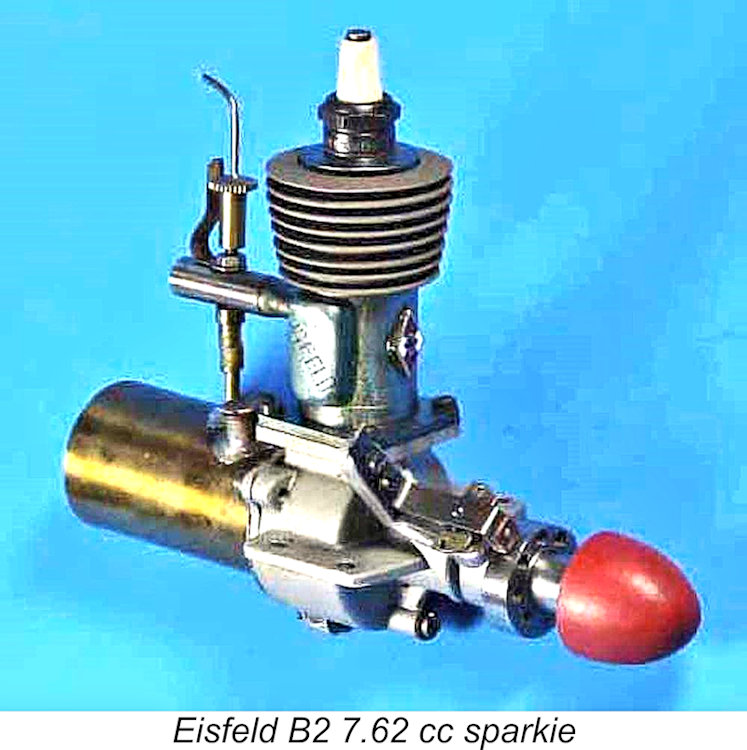 The Gustav Eisfeld machine tool company was established in Gera, eastern Germany in 1932.
The Gustav Eisfeld machine tool company was established in Gera, eastern Germany in 1932. 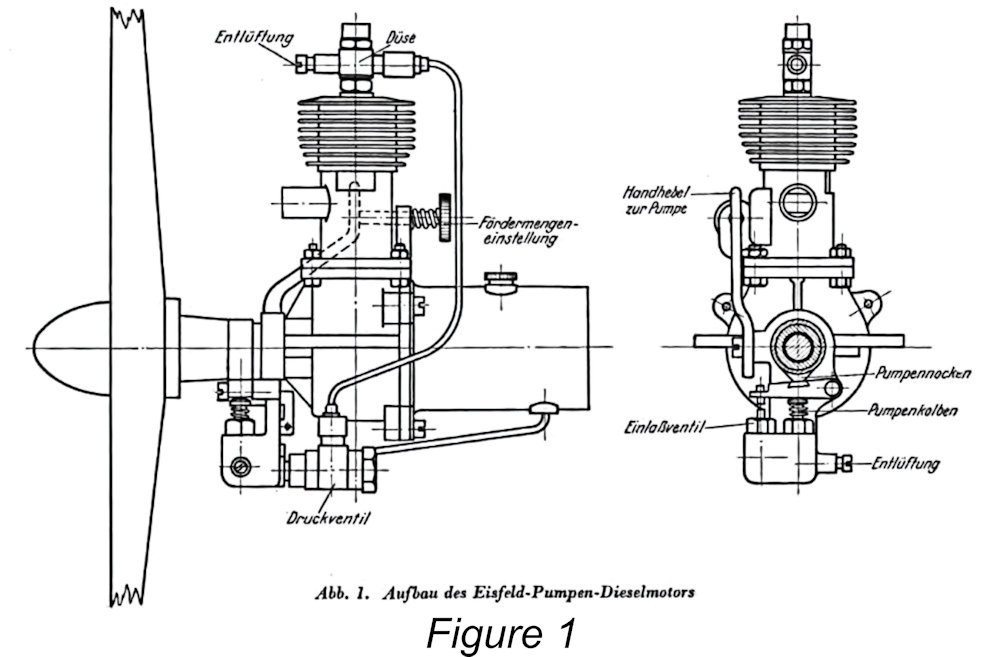 The development of the Eisfeld auto-ignition engines began in 1937. The engine which was built at that time had a displacement of 15 ccm, a compression ratio of 22:1, an adjustable injection pump and a needle injector. It ran on regular gasoil. Development of this engine was halted in view of the prevailing much greater ease of manufacture and superior reliability of the spark ignition engines of the time.
The development of the Eisfeld auto-ignition engines began in 1937. The engine which was built at that time had a displacement of 15 ccm, a compression ratio of 22:1, an adjustable injection pump and a needle injector. It ran on regular gasoil. Development of this engine was halted in view of the prevailing much greater ease of manufacture and superior reliability of the spark ignition engines of the time. 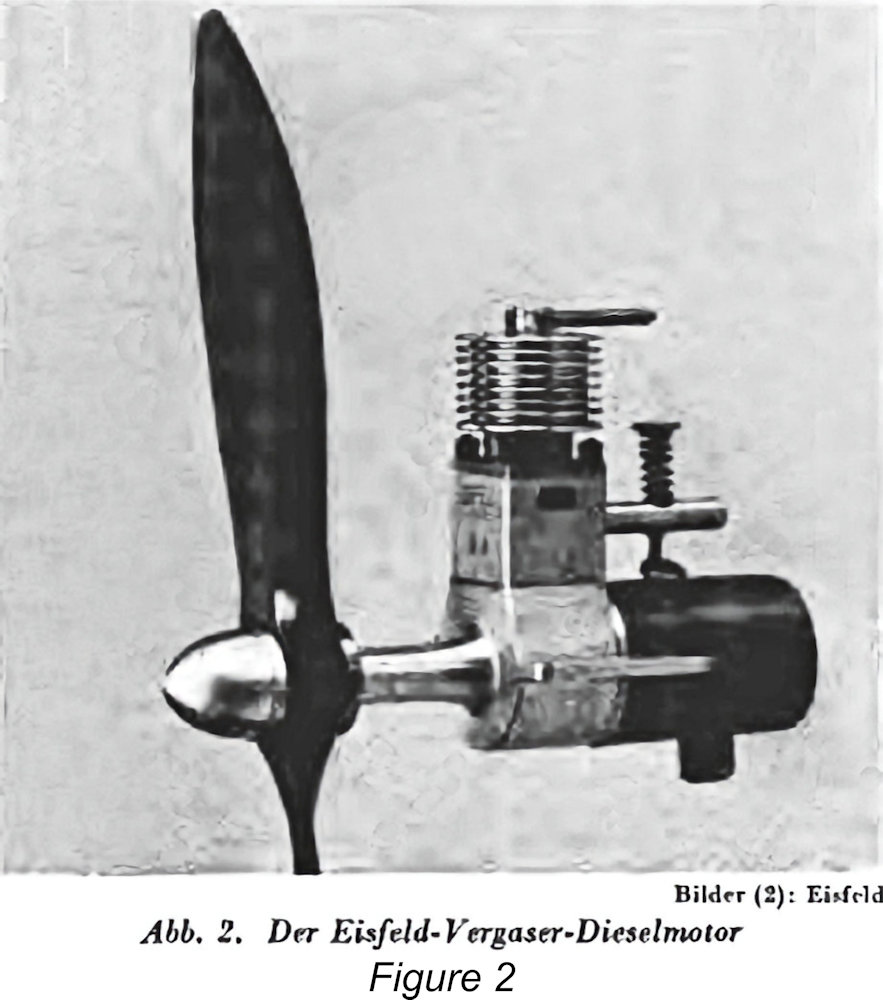 It was repeatedly noticed that model spark ignition engines with compression ratios of 6:1 or more would continue to run for some time after the ignition was shut off; also that hot engines could be brought to life. This realisation provided the motivation to develop a carburettor auto-ignition engine. However, tests in 1939 and 1940 had failed to demonstrate the ability to start from cold. The tests were therefore interrupted.
It was repeatedly noticed that model spark ignition engines with compression ratios of 6:1 or more would continue to run for some time after the ignition was shut off; also that hot engines could be brought to life. This realisation provided the motivation to develop a carburettor auto-ignition engine. However, tests in 1939 and 1940 had failed to demonstrate the ability to start from cold. The tests were therefore interrupted. 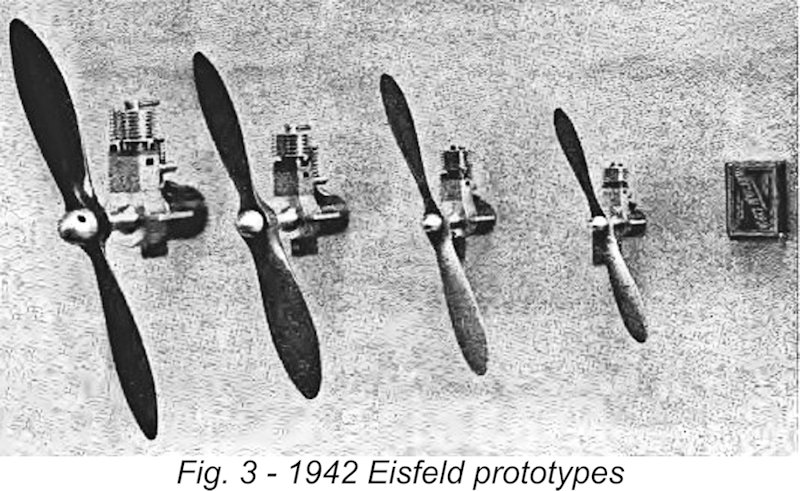
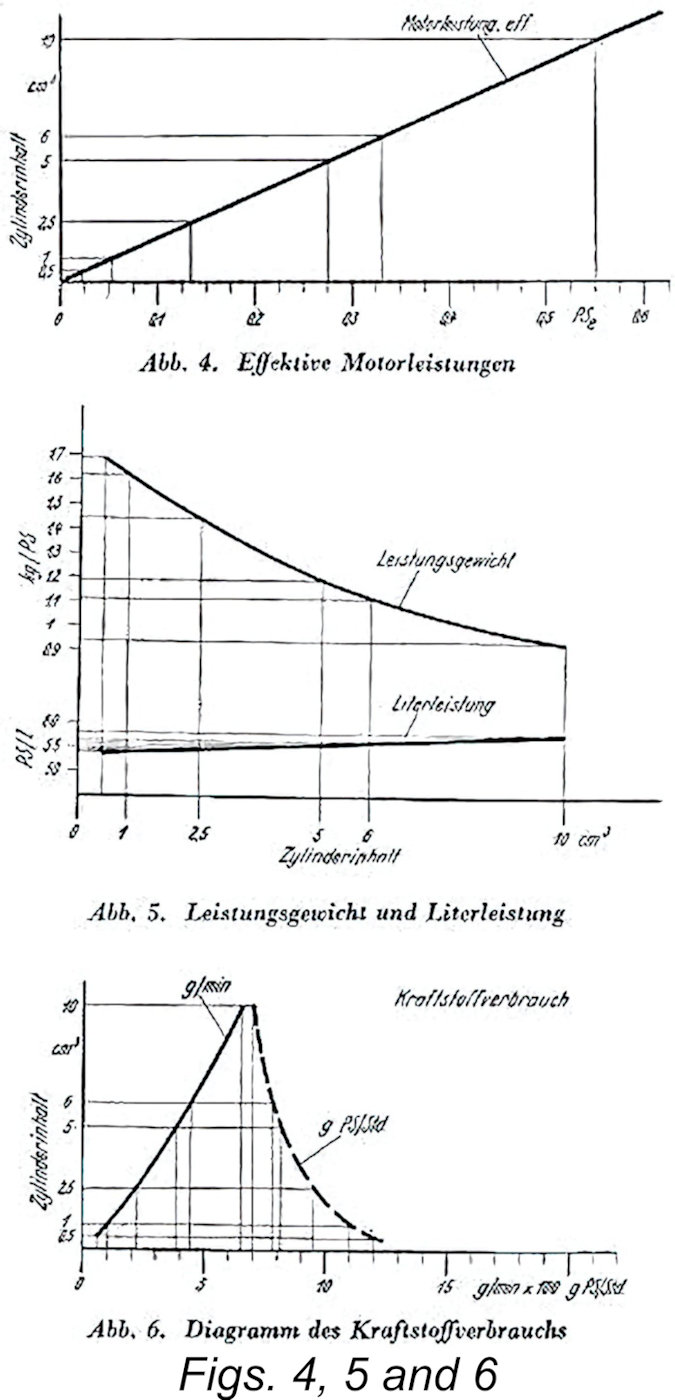 The development of the engines was spread over a long time. The results of the research proved the practical suitability of the carburettor auto-ignition engine for model airplane flying and the performance advantage over the gasoline engines. The effective power of the engines is shown in Fig. #4. The 6 ccm engine yields 0.33 HP. The power to weight and power to capacity is shown in Fig. #5. The weight per HP is higher for the smaller engines, from 0.93 kg/HP for 10 ccm to 1.98 kg/HP for 0.5 ccm. The power per litre is held within narrow limits, from 54 HP/litre for the 0.5 ccm to 58 HP/litre for the 10 ccm.
The development of the engines was spread over a long time. The results of the research proved the practical suitability of the carburettor auto-ignition engine for model airplane flying and the performance advantage over the gasoline engines. The effective power of the engines is shown in Fig. #4. The 6 ccm engine yields 0.33 HP. The power to weight and power to capacity is shown in Fig. #5. The weight per HP is higher for the smaller engines, from 0.93 kg/HP for 10 ccm to 1.98 kg/HP for 0.5 ccm. The power per litre is held within narrow limits, from 54 HP/litre for the 0.5 ccm to 58 HP/litre for the 10 ccm.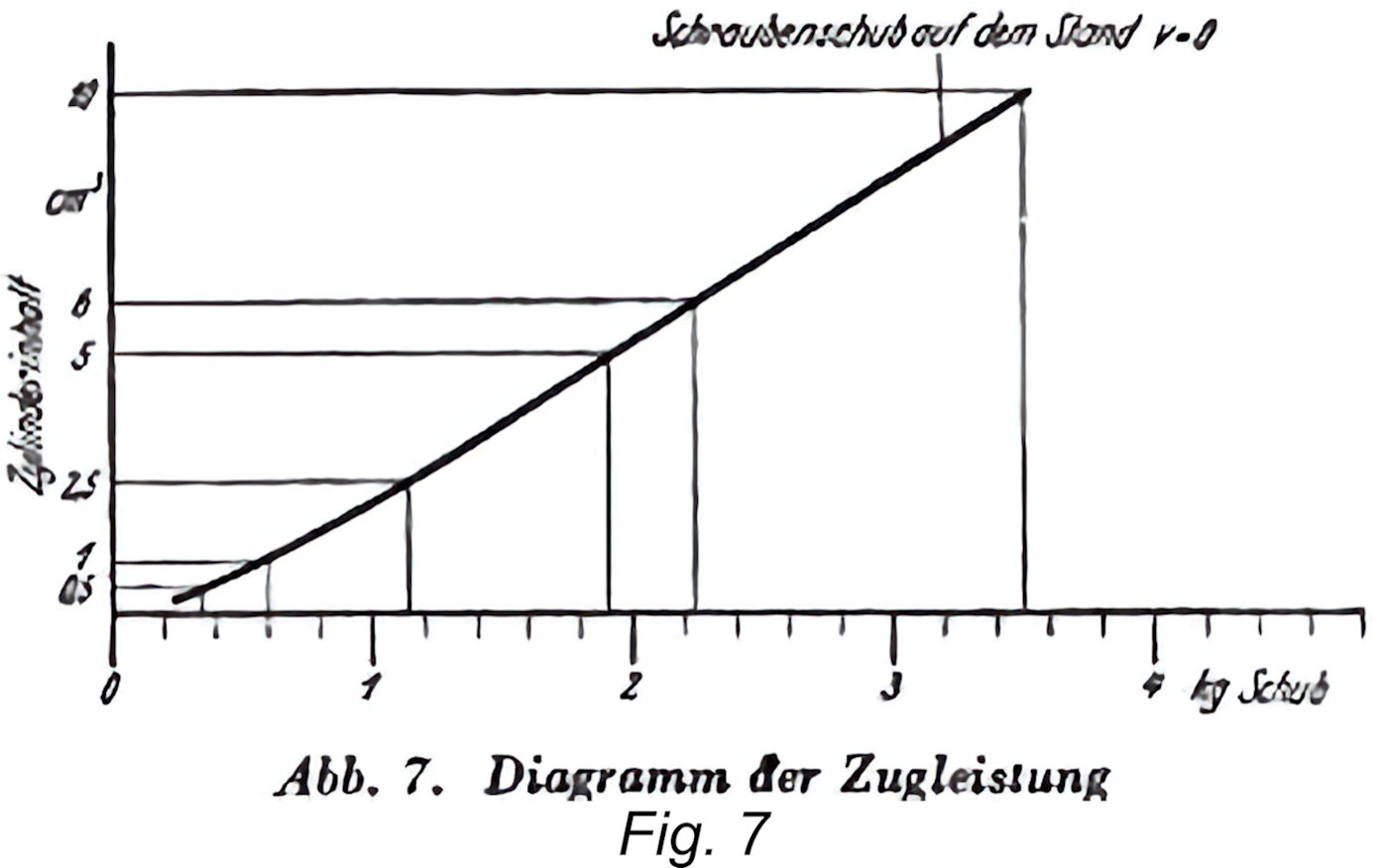 As a consequence of the higher power of the carburettor auto-ignition engine compared to the gasoline engine, a higher thrust is obtained from the airscrew; static thrust versus engine capacity is shown in fig. #7. The RPM at which these figures were measured are: 0.5 ccm – 9,500 RPM, 1.0 ccm – 9,000 RPM, 2.5 ccm – 6, 700 RPM, 5 ccm – 6,500 RPM, 6 ccm – 6,500 RPM, 10 ccm – 6,000 RPM. Further development was extended to robustness and running qualities. Because of the higher compression and instantaneous combustion with very high peak pressure, special dimensioning of the parts must be done for a useful lifetime.
As a consequence of the higher power of the carburettor auto-ignition engine compared to the gasoline engine, a higher thrust is obtained from the airscrew; static thrust versus engine capacity is shown in fig. #7. The RPM at which these figures were measured are: 0.5 ccm – 9,500 RPM, 1.0 ccm – 9,000 RPM, 2.5 ccm – 6, 700 RPM, 5 ccm – 6,500 RPM, 6 ccm – 6,500 RPM, 10 ccm – 6,000 RPM. Further development was extended to robustness and running qualities. Because of the higher compression and instantaneous combustion with very high peak pressure, special dimensioning of the parts must be done for a useful lifetime.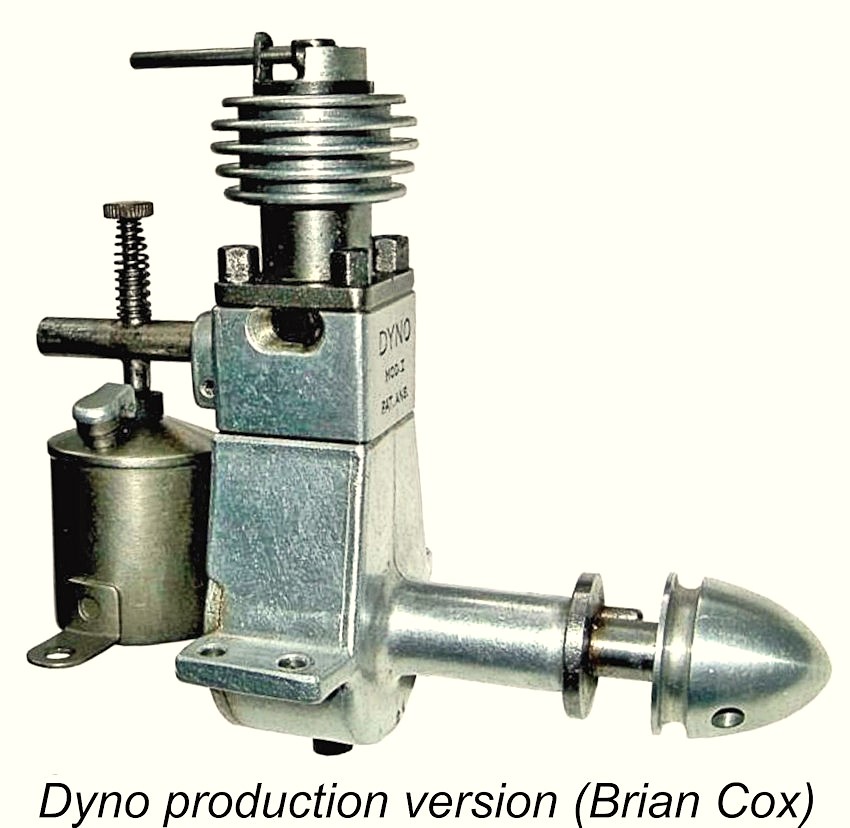 November 1941 - Der Deutsche Sportflieger
November 1941 - Der Deutsche Sportflieger 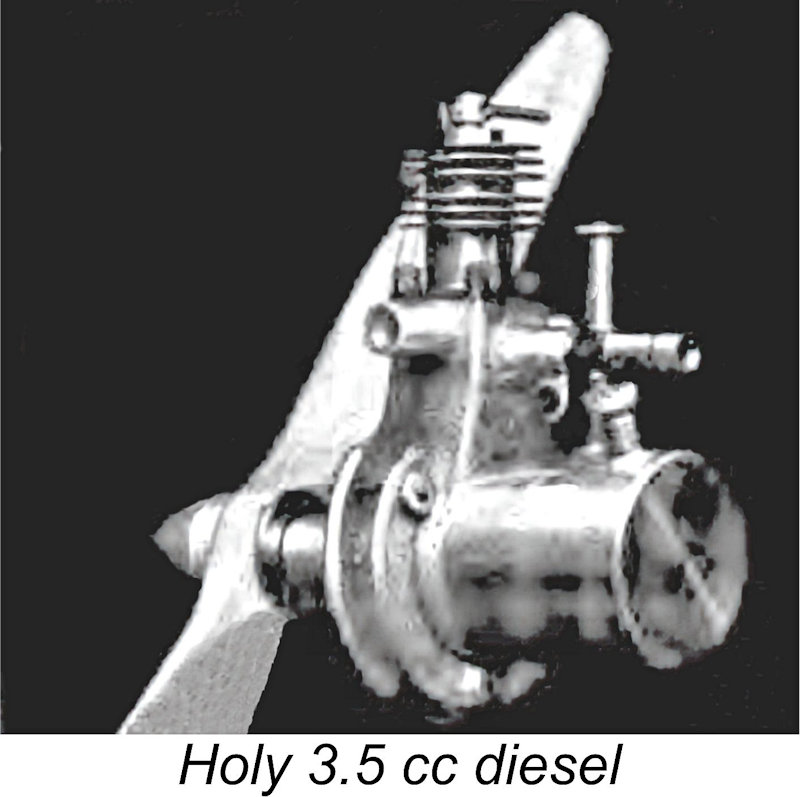 November 1943 - Luftwacht Modellflug
November 1943 - Luftwacht Modellflug 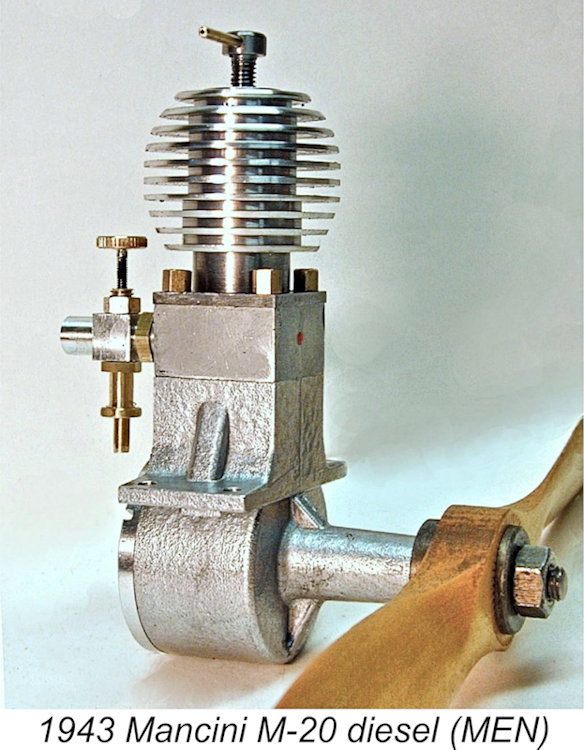
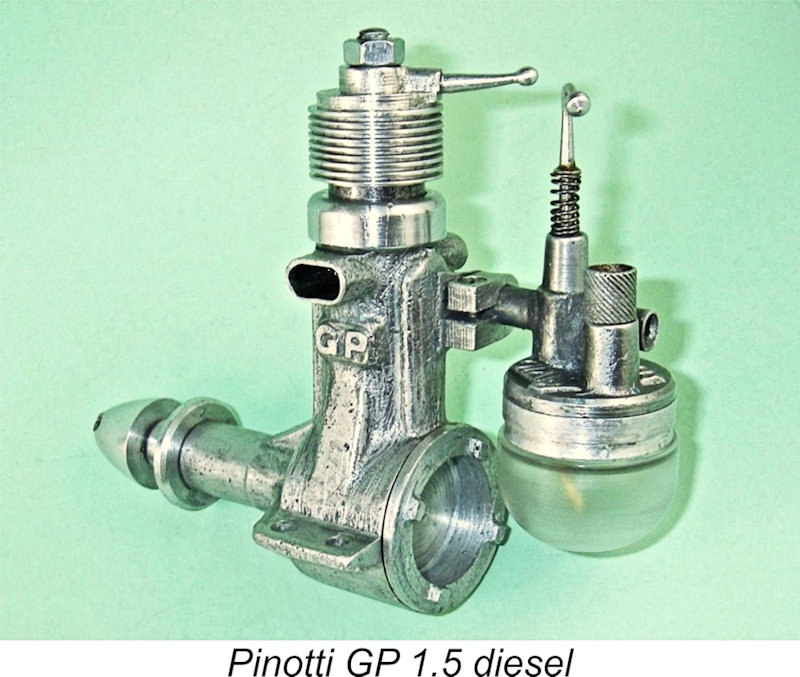
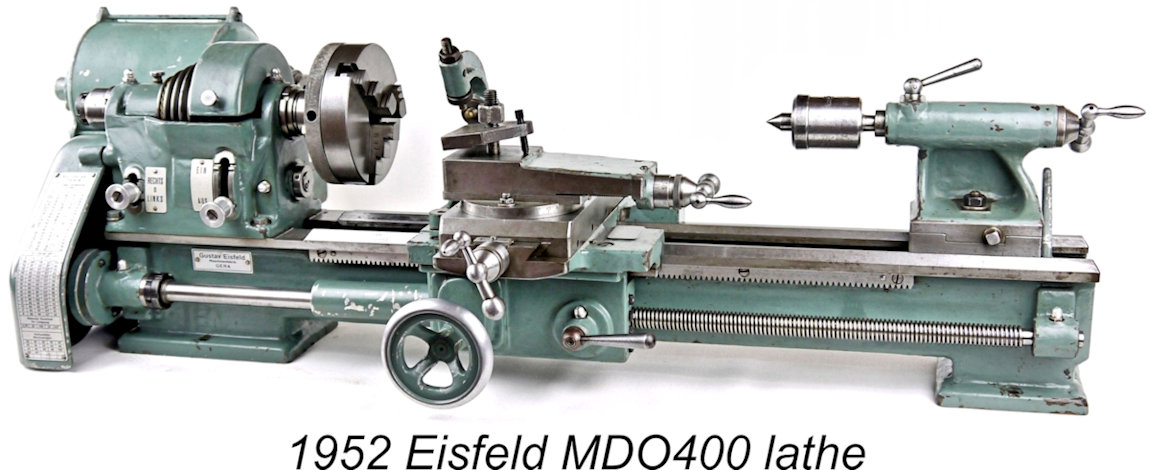
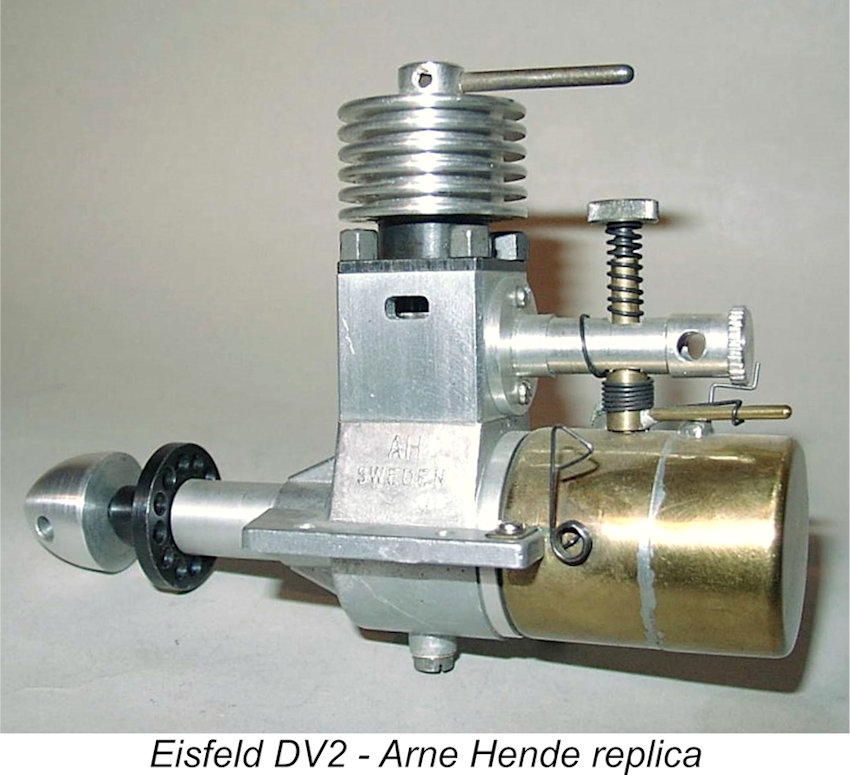
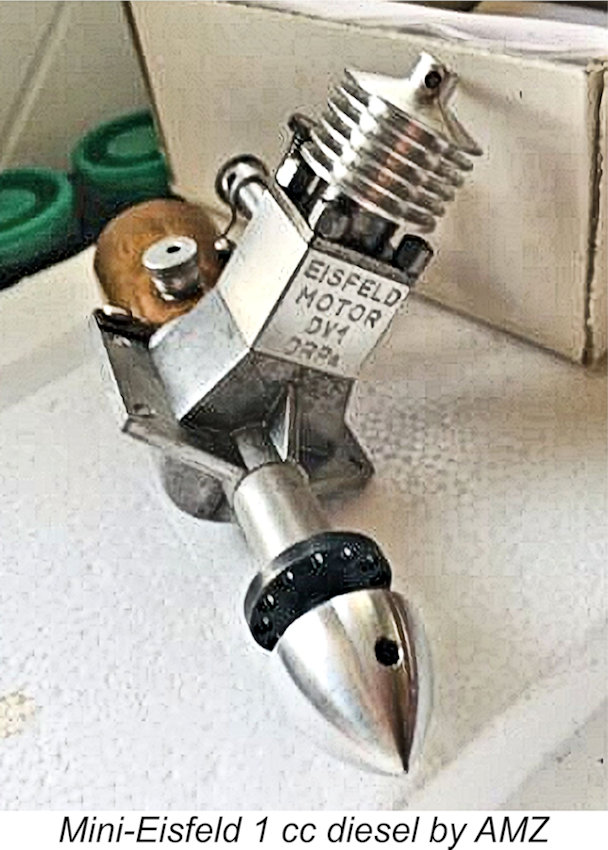 production owing to material shortages. By then, Eisfeld is said to have been more interested in small glow-plug engine technology. However, problematic availability of glow-plugs and fuel ingredients prevented any production of such engines.
production owing to material shortages. By then, Eisfeld is said to have been more interested in small glow-plug engine technology. However, problematic availability of glow-plugs and fuel ingredients prevented any production of such engines. 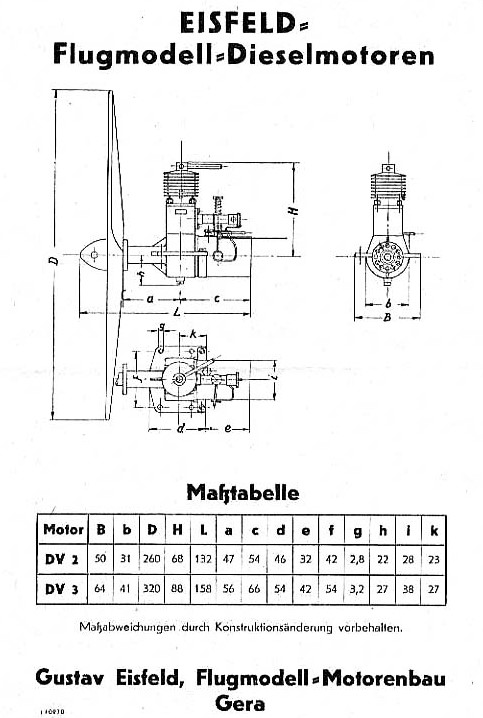 The Eisfeld DV2 and DV3 models appear to have been the only Eisfeld diesels to reach series production, and then for only a relatively short time. The accompanying information sheet produced by the factory provides the major dimensions of these two models.
The Eisfeld DV2 and DV3 models appear to have been the only Eisfeld diesels to reach series production, and then for only a relatively short time. The accompanying information sheet produced by the factory provides the major dimensions of these two models. 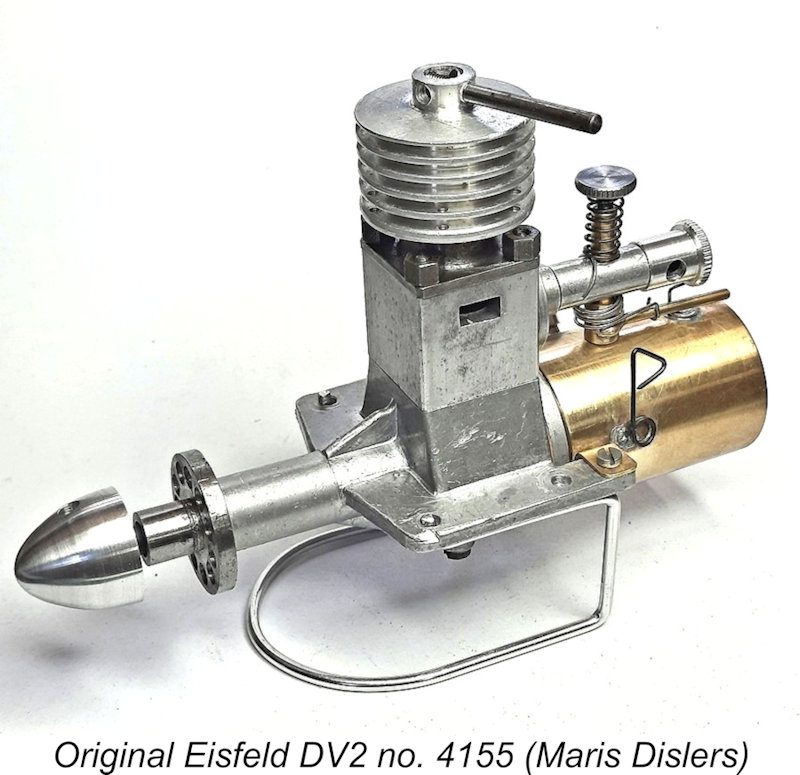
 The arrangement used comprised two transfer ports (one either side of the exhaust port) directing charge away from the exhaust across the flat-top piston to the far side of the cylinder to achieve loop scavenging without a baffle. Its use in the Eisfeld diesels predated the Danish
The arrangement used comprised two transfer ports (one either side of the exhaust port) directing charge away from the exhaust across the flat-top piston to the far side of the cylinder to achieve loop scavenging without a baffle. Its use in the Eisfeld diesels predated the Danish 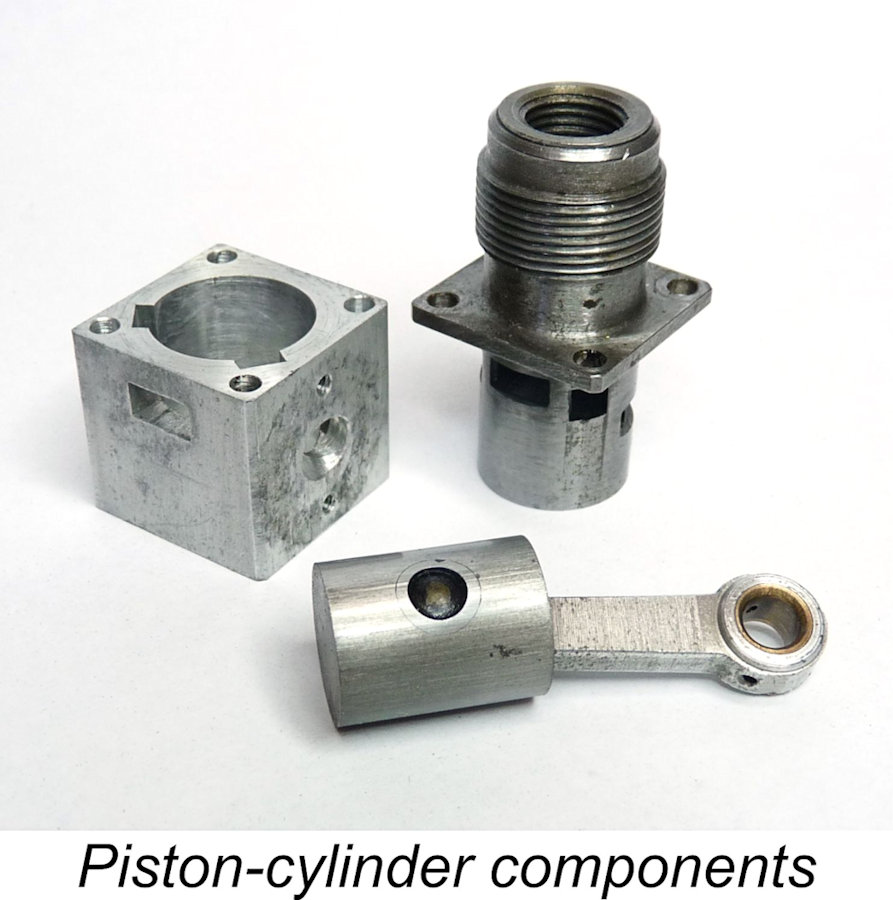 The incoming charge turns 90 degrees in the upper cylinder block to enter the cylinder’s wide induction port at a tangent. All ports are broached square-rectangular apertures, providing accurate flow paths and rapid port opening and closing. The block also has vertical bypass passages feeding the transfers. Port timing is 90 degrees intake, 110 degrees transfer, 132 degrees exhaust. Bore and stroke are 13.97 mm (0.55 in.) and 15.86 mm (0.624 in.) respectively for a swept volume of 2.43 cc (0.148 cui
The incoming charge turns 90 degrees in the upper cylinder block to enter the cylinder’s wide induction port at a tangent. All ports are broached square-rectangular apertures, providing accurate flow paths and rapid port opening and closing. The block also has vertical bypass passages feeding the transfers. Port timing is 90 degrees intake, 110 degrees transfer, 132 degrees exhaust. Bore and stroke are 13.97 mm (0.55 in.) and 15.86 mm (0.624 in.) respectively for a swept volume of 2.43 cc (0.148 cui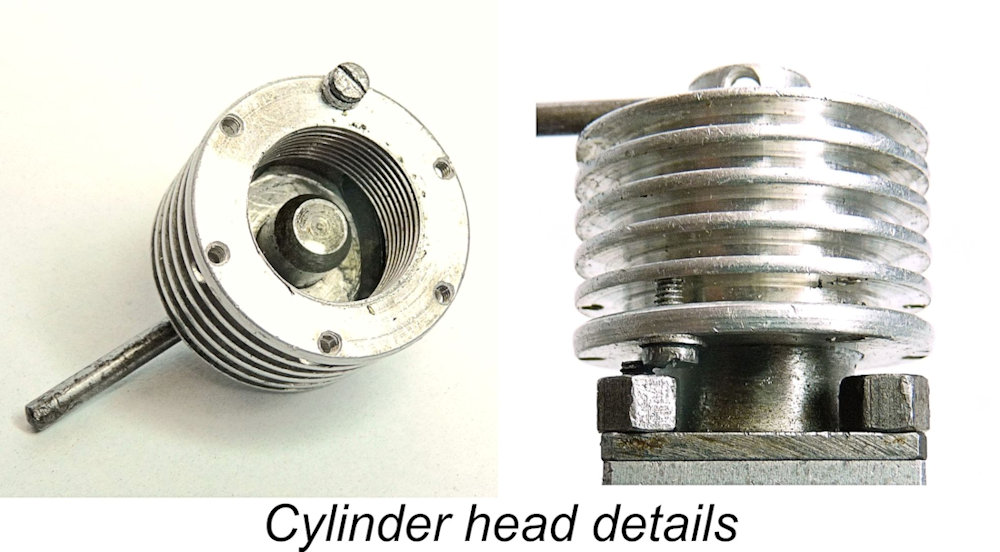
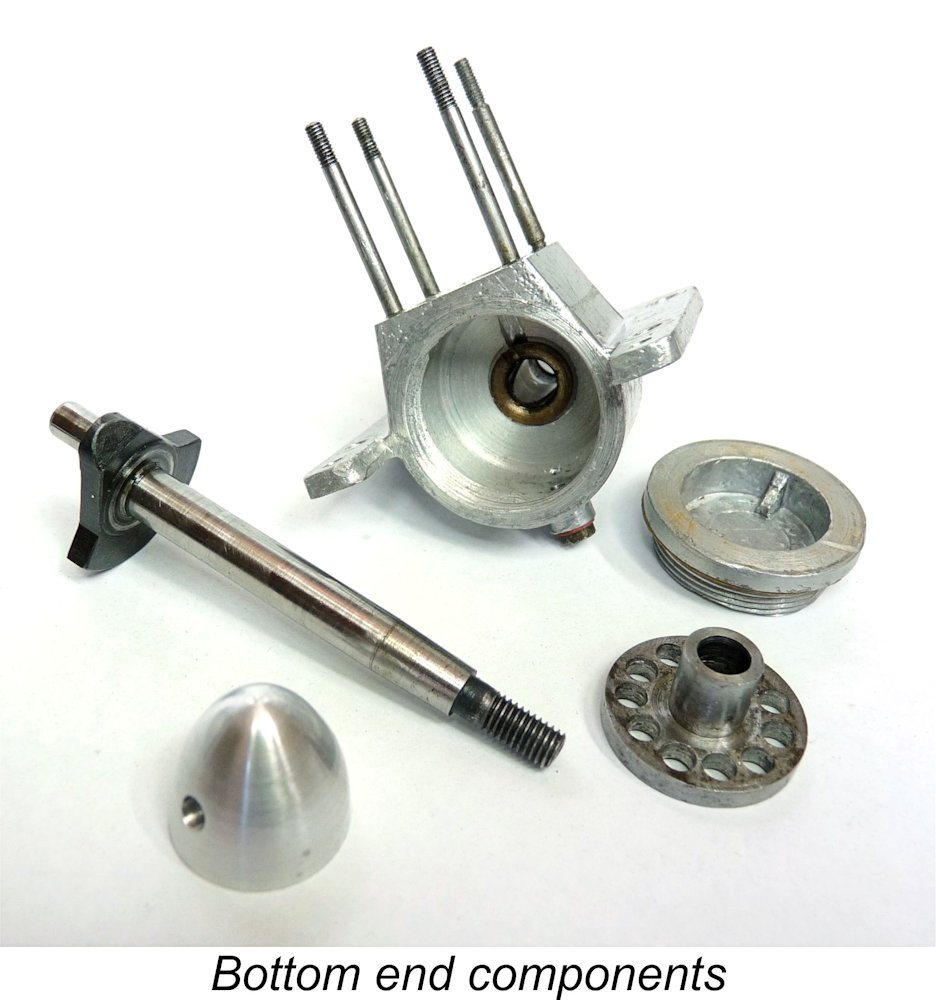
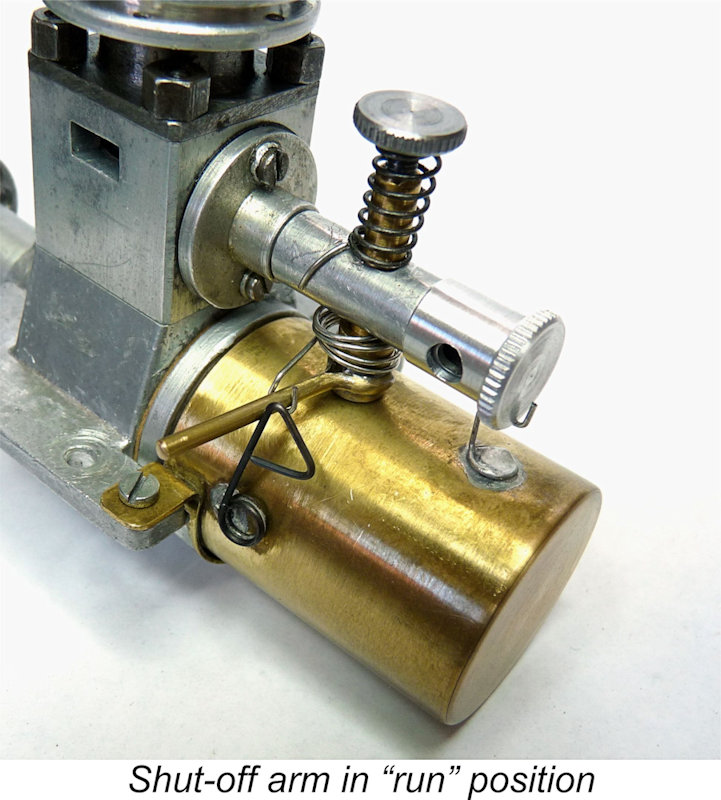 Gustav Eisfeld intended engine speed adjustment to be made via the carburettor choke control, rather than by varying the compression. This was perhaps an unnecessary complication, but not so the shut-off device given the generous fuel tank volume. This device uses the air bleed method via a sleeve over the spraybar below the intake tube. When the sleeve’s control arm is set for running, in front of the sprung trigger on the side of the tank, the respective sleeve and spraybar holes are perpendicular, hence being closed. Pulling back the trigger by hand or with an Autoknips clockwork camera shutter release allows the sleeve to spring back to align the two holes, breaking fuel suction and starving the engine.
Gustav Eisfeld intended engine speed adjustment to be made via the carburettor choke control, rather than by varying the compression. This was perhaps an unnecessary complication, but not so the shut-off device given the generous fuel tank volume. This device uses the air bleed method via a sleeve over the spraybar below the intake tube. When the sleeve’s control arm is set for running, in front of the sprung trigger on the side of the tank, the respective sleeve and spraybar holes are perpendicular, hence being closed. Pulling back the trigger by hand or with an Autoknips clockwork camera shutter release allows the sleeve to spring back to align the two holes, breaking fuel suction and starving the engine.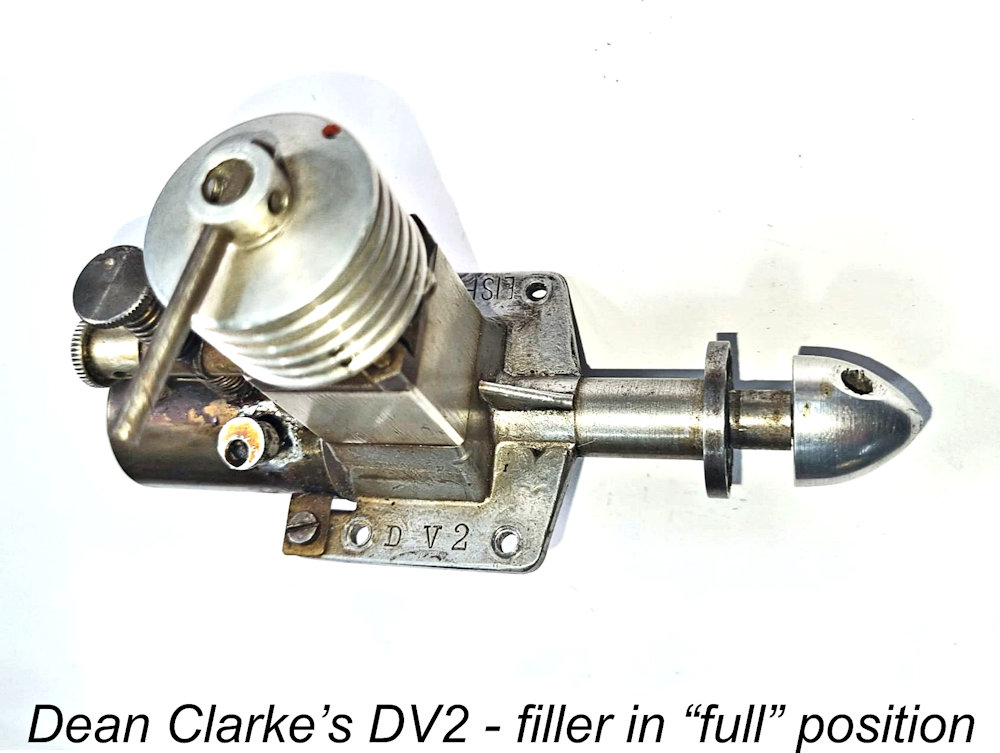
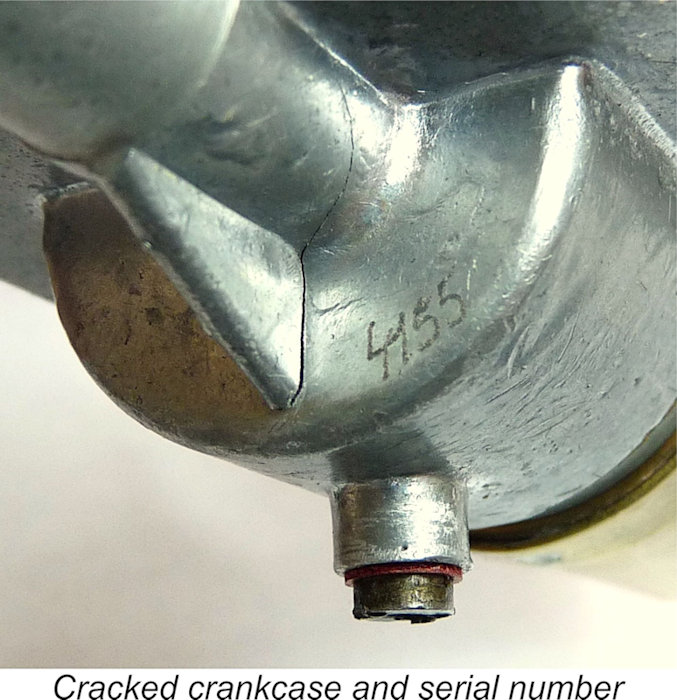 Unfortunately, my DV2 is a non-runner owing to crash damage sustained in its former life, resulting in a cracked and distorted crankcase. No DV3 is available. However, Helmut Glockman’s previously-cited article in the May/June 1944 issue of “Modellflug” described his calibrated propeller performance measuring method, along with power curves for the contemporary Eisfeld and Kratmo spark ignition engines, the Eisfeld DV2 and DV3 diesels and the Dyno 1 diesel.
Unfortunately, my DV2 is a non-runner owing to crash damage sustained in its former life, resulting in a cracked and distorted crankcase. No DV3 is available. However, Helmut Glockman’s previously-cited article in the May/June 1944 issue of “Modellflug” described his calibrated propeller performance measuring method, along with power curves for the contemporary Eisfeld and Kratmo spark ignition engines, the Eisfeld DV2 and DV3 diesels and the Dyno 1 diesel.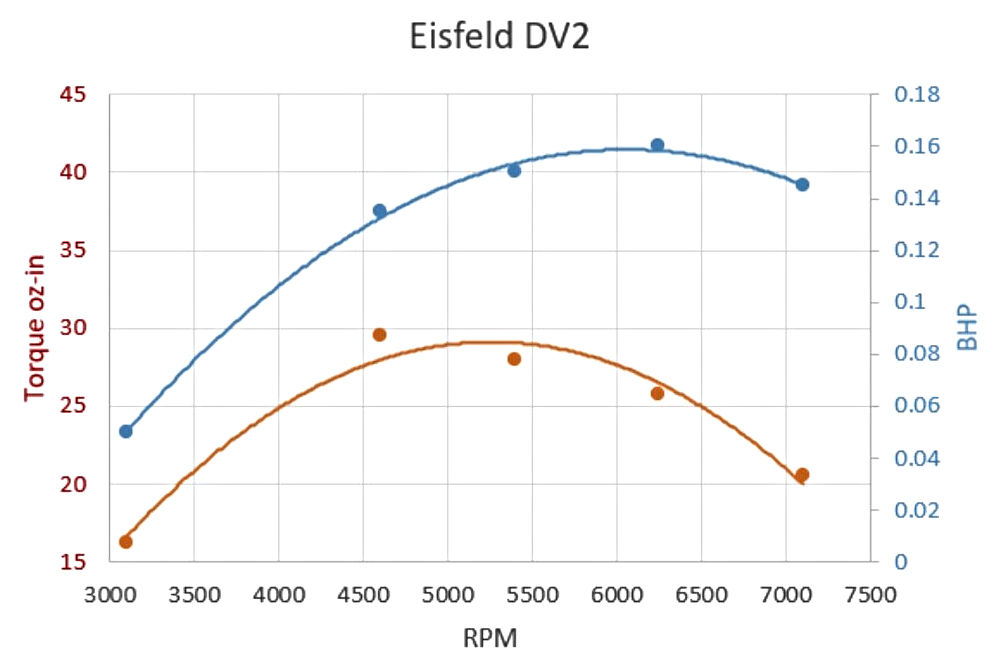
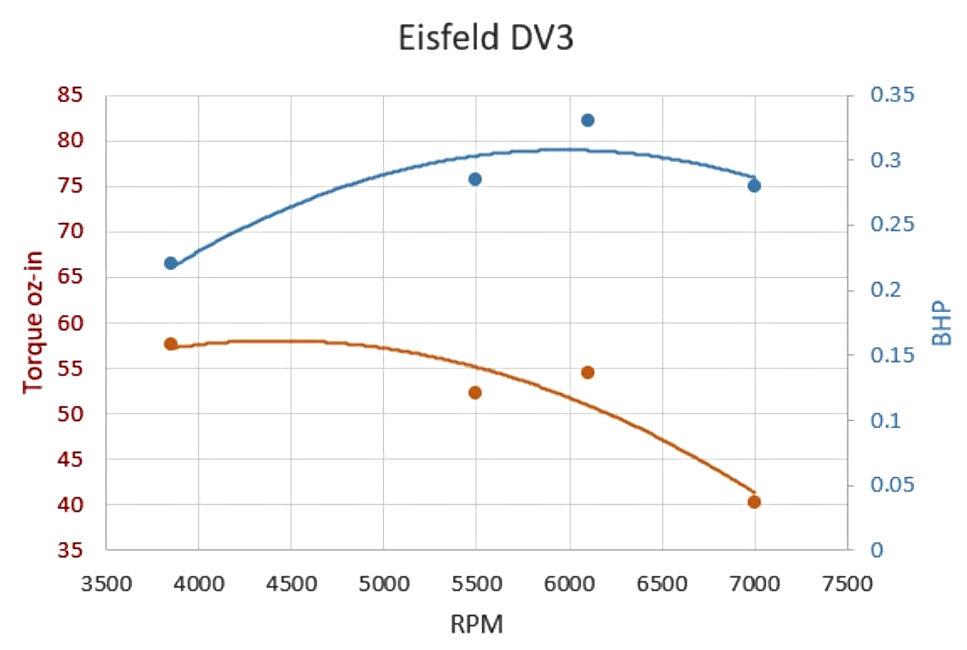
 When reviewing Gustav Eisfeld’s diesels, I glossed over his spark ignition engines. They were, of course, the main players in the Eisfeld model engine range. Made to a common design but in different sizes, they generally followed then-current German model engine design trends when introduced in 1938, featuring cast aluminium crankcases with bronze crankshaft bushings, beam mounts and rear fuel tanks mounted via their flanges and retained by the backplate fastening screws.
When reviewing Gustav Eisfeld’s diesels, I glossed over his spark ignition engines. They were, of course, the main players in the Eisfeld model engine range. Made to a common design but in different sizes, they generally followed then-current German model engine design trends when introduced in 1938, featuring cast aluminium crankcases with bronze crankshaft bushings, beam mounts and rear fuel tanks mounted via their flanges and retained by the backplate fastening screws.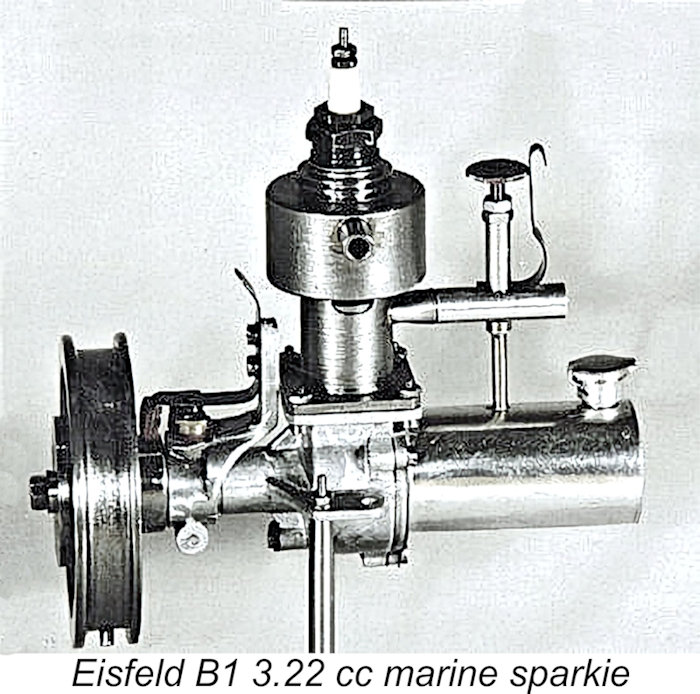 Other features included; steel cylinder with blind bore and base mounting flange; screw-on aluminium cooling fins; cast iron piston; steel conrod; brazed-on bypass cover (stamped EISFELD); rear intake tube; and crossflow porting.
Other features included; steel cylinder with blind bore and base mounting flange; screw-on aluminium cooling fins; cast iron piston; steel conrod; brazed-on bypass cover (stamped EISFELD); rear intake tube; and crossflow porting.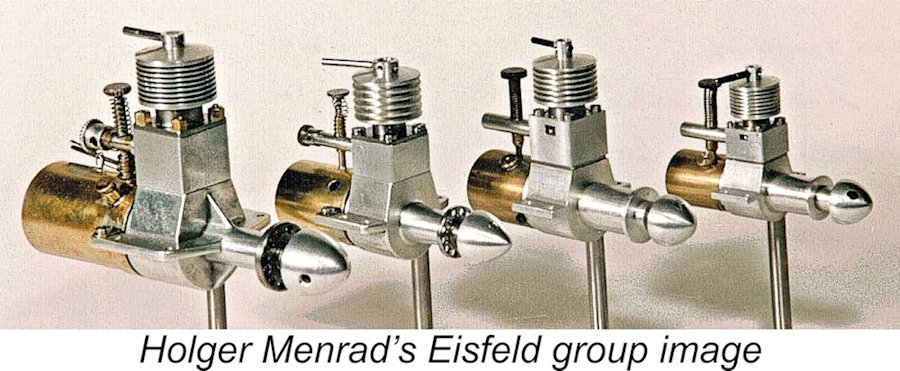
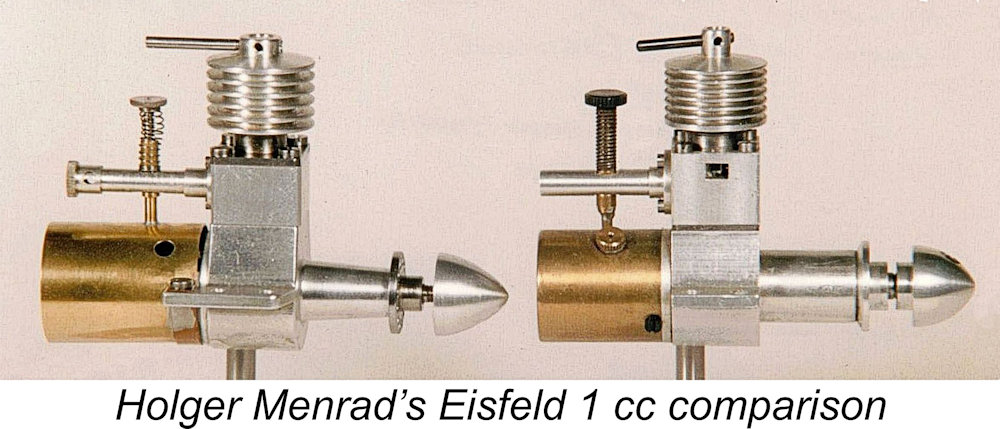
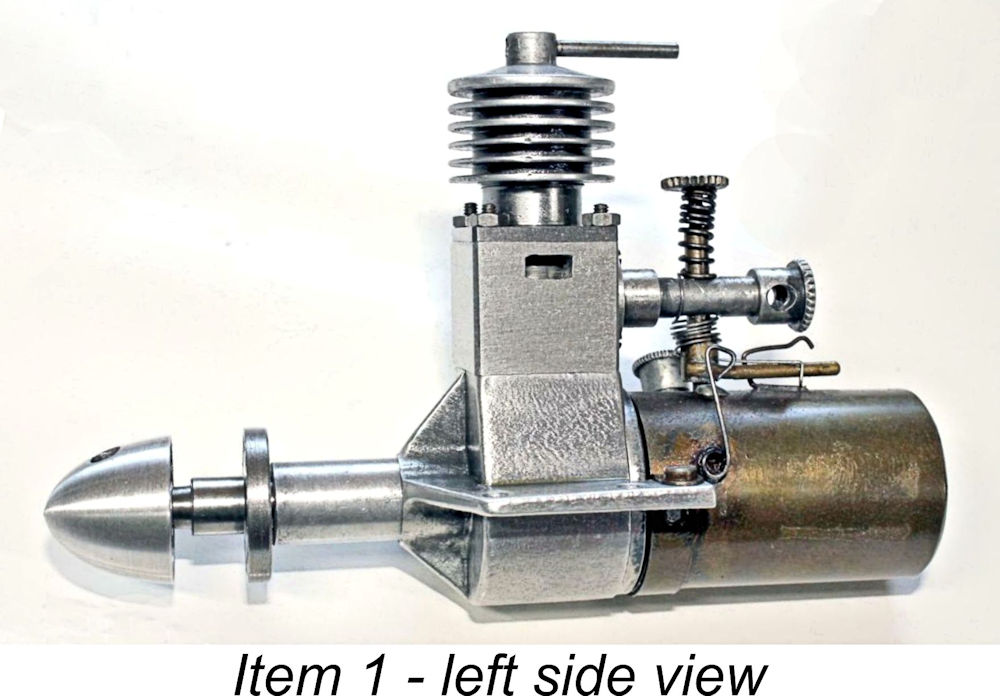
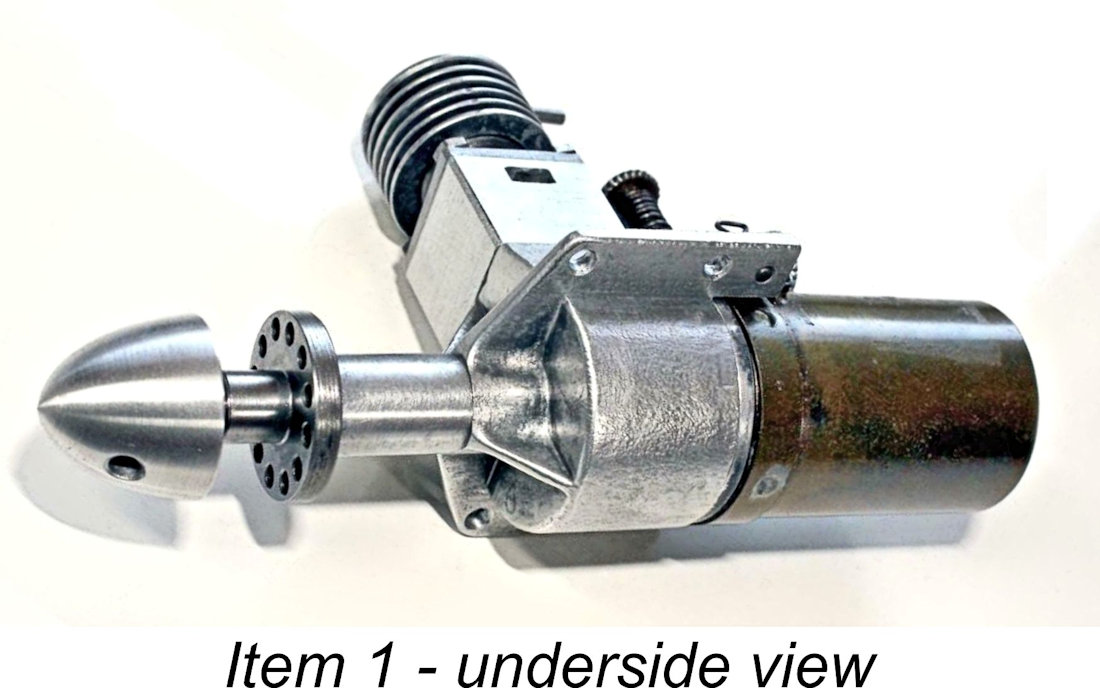
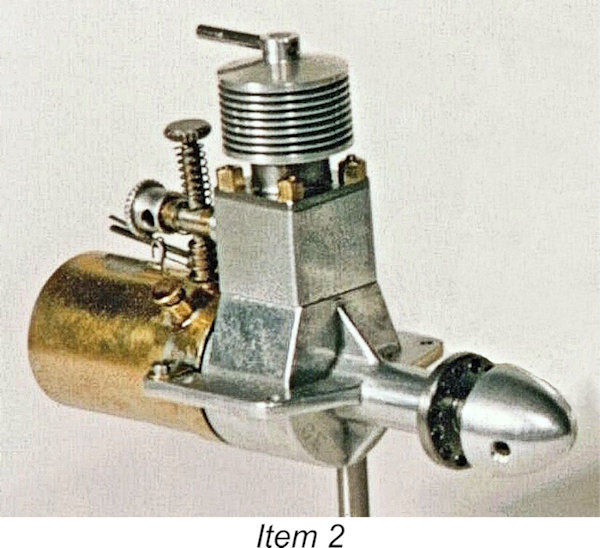 Item 2: Image cut from Holger Menrad's previously-reproduced group photo including items 4 and 5. Presumed to be 2.5 cc. It has more cooling fins than the DV2. The taller top crankcase web and lack of a
Item 2: Image cut from Holger Menrad's previously-reproduced group photo including items 4 and 5. Presumed to be 2.5 cc. It has more cooling fins than the DV2. The taller top crankcase web and lack of a 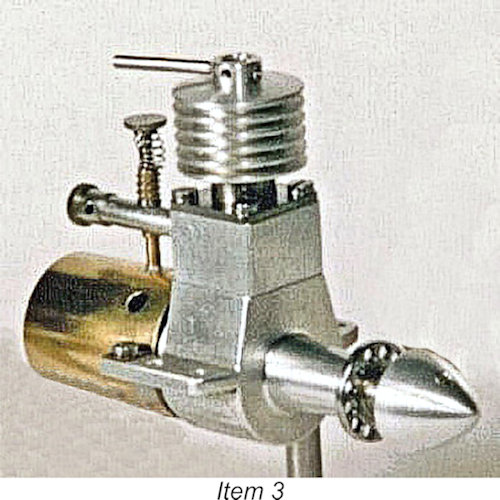
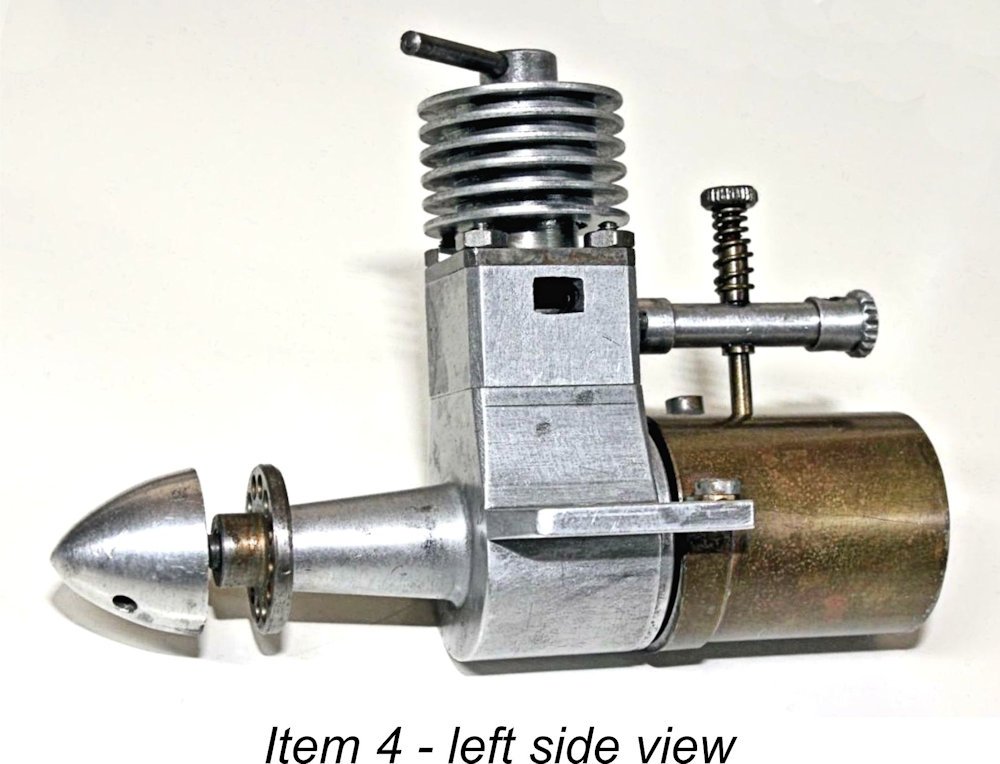
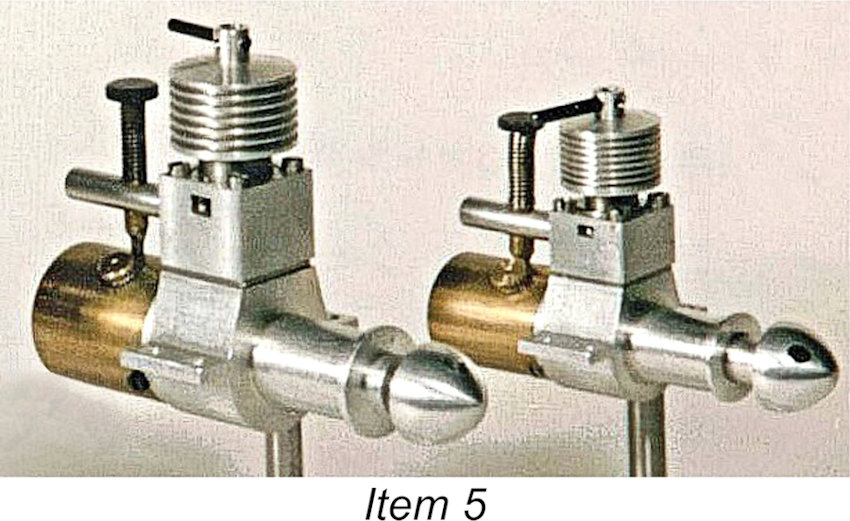
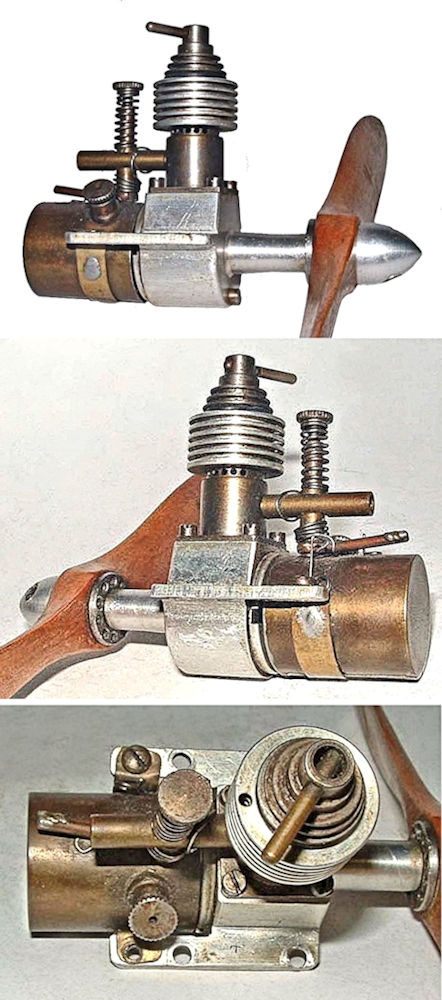
 The two units incorporate unquestionable Eisfeld diesel fuel tank assemblies but depart significantly from the larger production engines and the 1942-1943 experimental 0.5 cc type. They feature crankcase bleed screws like the spark ignition Eisfelds. Two distinct cylinder designs strongly suggest that these were development prototypes. Indeed, anecdotal evidence suggests that Gustav later contemplated making small glow-plug engines as a continuation of the theme.
The two units incorporate unquestionable Eisfeld diesel fuel tank assemblies but depart significantly from the larger production engines and the 1942-1943 experimental 0.5 cc type. They feature crankcase bleed screws like the spark ignition Eisfelds. Two distinct cylinder designs strongly suggest that these were development prototypes. Indeed, anecdotal evidence suggests that Gustav later contemplated making small glow-plug engines as a continuation of the theme.